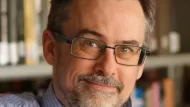We all remember that day: How we first heard, whom we were with, how we felt as we watched an iconic American cityscape transformed into a burning, toxic wreckage, knowing that thousands were surely dead, many never to be found. We can all too easily recall how our disbelief quickly turned to horror, sadness and then fear – a fear that the world was now a fundamentally different place, and what that would mean for ourselves and our children.
We all remember that day: How we first heard, whom we were with, how we felt as we watched an iconic American cityscape transformed into a burning, toxic wreckage, knowing that thousands were surely dead, many never to be found. We can all too easily recall how our disbelief quickly turned to horror, sadness and then fear – a fear that the world was now a fundamentally different place, and what that would mean for ourselves and our children.
In many ways our fears were borne out. The world is a very different place than it was on the morning of September 11th, 2001, wrought as it has been by a series of wars and the apparent growth in irrational fears of immigrants and associated political extremism. And our lives are certainly more scrutinized, particularly in urban areas where sophisticated cameras and sensing technology can follow our moves and transactions with unnerving accuracy. In addition, with the costs of the "war on terror" now estimated to exceed $5 trillion, we must reflect on the "opportunity costs" that this figure represents: investments that could have been made into America's infrastructure, renewable energy and other urban amenities that instead went into the interminable and controversial wars in Afghanistan and Iraq. Indeed, the U.S. Conference of Mayors issued a statement at their June meeting which called on President Obama to bring these wars to an early end and redirect dollars to urban needs and to building a new, sustainable economy.
However, with the anniversary of the 9/11 attacks it is important to reflect on the many ways in which the world did not change. This is particularly true when we consider what was widely believed in planning circles would be the consequences for cities.
Within days of the attacks, planners began exchanging their thoughts on listservs, as well as in print and online. In seeking to come to terms with the scale of the urban destruction and the shock of mass death, the authors of dozens of posts, articles and a few early blog entries tried to articulate how the events would affect cities, the planning profession and the world. In 2003, Joe Nasr summarized this literature in the pages of the Journal of Planning History in an article "Planning Histories, Urban Futures, and the World Trade Center Attack." What he revealed in the literature was that many believed the attacks signaled the end of the construction of new skyscrapers; of urban density and agglomeration (faciliated by advances in telecommunication); and the end of the urban renaissance in general. Others countered that such concerns were misplaced and that there would always be a demand for dense financial districts. Nasr found that those arguing against the future viability of density tended to have a "conservative bent," while other historians he dubbed "defenders of cities" argued that the vulnerability of cities could not be decreased by scattering them further – and indeed, given the attendant energy security issues involved, would only exacerbate it*.
From the perspective of 2011, however, it is fascinating to see how the urban fears of 2001 have, by and large, not been realized. Increasingly tall skycrapers have been built – including the Burj Khalifa in Dubai, which exceeds 160 storeys, while an even taller structure, the 1 kilometre tall Kingdom Tower, is being planned for Jeddah, Saudi Arabia. In his recent book, The Triumph of the City, author Edward Glaeser trumpeted the powerful role of the skyscraper in contributing to urban sustainability and vitality. Far from dissipating their functions to the suburbs, cities have continued to attract residents: indeed, in 2009 Planetizen cited the "Return to the City" as one of the top planning trends of the previous year, as young professionals are seeking to work and live near the centre to be a part of the "creative economy" and as a means to avoid high travel costs. And of course, the "Ground Zero" site itself continues to be rebuilt, with One World Trade Center – which will be the tallest building in the United States – slated for completion in 2013.
An important lesson we can take from this history is that towns and cities are resilient. By resilience we mean the ability of cities, towns or neighborhoods to
respond effectively to distruptions, disasters and challenges by virtue
of their flexibility, diversity and built-in redundancies. Like a
successful species or enduring habitat in the natural world, a
resilient city continues to maintain its primary functions even as its
circumstances change. Such cities are flexible and adaptable, and capable of resuming their former roles and functions following a major disruption. Or more specifically, the people that live within them are: Despite the impacts of disaster, weather, war or terrorism, people rebuild the places they love, even in the face of fear and the predictions of doomsayers. This resilience is particularly evident in Lower Manhattan, which, ten years later is thriving as never before. As Shawn McCarthy reports for the Globe and Mail, the residential population has doubled thanks to investments in new urban amenities including parks and schools, and a range of new enterprises is rushing to set up business there.
As we remember and reflect on the tragic events of September 11th, 2001, there is another key lesson we can discern – one that was, in fact, articulated within days of the events: that planning has an important role to play in the creation of a more just and peaceful world. Communities which are healthy, ecologically sustainable, socially equitable and provide opportunities for all are less likely to be riven by hostility, war and terrorism. In their joint statement on behalf of the Association of Collegiate Schools of Planning dated September 14th 2001, Bruce Stiftel, Christopher Silver, Susan Bradbury and Wim Wiewel put it this way:
[planners] have dedicated [themselves] to bringing people together to form common visions of the future The anger and sadness we feel today as planners must give way to recognition that our work bringing people together behind common interests and collective purposes is vital to building the understanding across nationalities, races and political views that is essential to peace.
Then as now, words to plan by.
*The author is cited in this article.

Planetizen Federal Action Tracker
A weekly monitor of how Trump’s orders and actions are impacting planners and planning in America.

Canada vs. Kamala: Whose Liberal Housing Platform Comes Out on Top?
As Canada votes for a new Prime Minister, what can America learn from the leading liberal candidate of its neighbor to the north?

USGS Water Science Centers Targeted for Closure
If their work is suspended, states could lose a valuable resource for monitoring, understanding, and managing water resources.

Austin’s Building Boom Not Reaching Lowest-Income Families
Despite having the highest rate of affordable housing construction in the nation, Austin is still underproducing housing for the neediest households.

New Indianapolis Bridge Prioritizes Walking, Biking
Over half the surface of the Fall Creek Bridge is devoted to walking and biking paths.

New Hampshire House Passes Parking Reform Bill
The revised bill, which caps parking requirements at one spot per residential unit and eliminates exemptions, will go back to the Senate for a new vote.
Urban Design for Planners 1: Software Tools
This six-course series explores essential urban design concepts using open source software and equips planners with the tools they need to participate fully in the urban design process.
Planning for Universal Design
Learn the tools for implementing Universal Design in planning regulations.
New York City School Construction Authority
Village of Glen Ellyn
Central Transportation Planning Staff/Boston Region MPO
Chaddick Institute at DePaul University
Institute for Housing and Urban Development Studies (IHS)
City of Grandview
Regional Transportation Commission of Southern Nevada
Toledo-Lucas County Plan Commissions



























